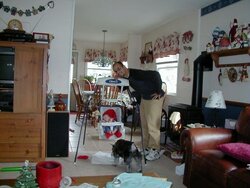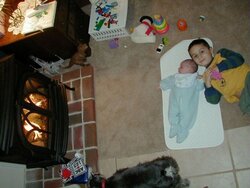I'm hoping someone here has experience with free standing gas stoves and can give me some advice........
I'm planning on taking down the existing brick fireplace in my home, which is very poorly located (and notoriously inefficient anyway), and replacing it with a free standing gas stove. I've got my eye on the Vermont Radiance. I want it to heat my living room/foyer and kitchen/family dining area; around 900 square feet. The stove will be centrally located, almost in the middle of this area, on a short 3' wall, so it will be open to full view on 3 sides.
What I'm worried about is how much heat I'm going to be dealing with from the gas stove. The Radiance is probably a little big for the area, and the turndown is not as low as an equivalent Jotul. But the smaller Vermont Stardance is not considered a good stove (according to my salesman), and the equivalent Jotuls have a major esthetic drawback for me - their backsides jut way farther out than the Vermont stoves and look really ugly when viewed from the sides, and my stove will be very viewable from three sides. Also I like the Vermont colors much better than the Jotul colors.
So assuming that I get a Radiance, it is going to be pumping out a lot of heat and I'm wondering what it will be like to sit nearby? How close can I locate people and furniture to the sides of the stove? I was told that unlike a woodburning cast iron stove, which gets very warm on all surfaces and radiates heat into the room from all surfaces, the gas stove doesn't do this. I'm told most of the heat comes out the front. Is this correct???? This is really important because our dining table will be located only about 4' from the left side of the stove, and I don't want diners on the side of the table nearest the stove feeling as though they were cooking! And I don't want my furniture to dry out from too much nearby heat. Do I have to worry about this?
Also, though I'm in a very cold microclimate of the San Francisco Bay Area, and winter nights and mornings are particularly cold (25 - 35 degrees at night on average during the winter months), the day time temps are almost always well above freezing, so I expect the stove will cycle on and off quite a bit. Are there any drawbacks to this? Is it noisy? Inefficient? Hard on the unit?
Also, since this stove will be located nearly centrally in this 900 square foot area, how well can I expect it to heat the air spaces behind it (about half the area)? Will I need a ceiling fan? If so, where would I have to locate it?
Would greatly appreciate some good advice!
Jan
I'm planning on taking down the existing brick fireplace in my home, which is very poorly located (and notoriously inefficient anyway), and replacing it with a free standing gas stove. I've got my eye on the Vermont Radiance. I want it to heat my living room/foyer and kitchen/family dining area; around 900 square feet. The stove will be centrally located, almost in the middle of this area, on a short 3' wall, so it will be open to full view on 3 sides.
What I'm worried about is how much heat I'm going to be dealing with from the gas stove. The Radiance is probably a little big for the area, and the turndown is not as low as an equivalent Jotul. But the smaller Vermont Stardance is not considered a good stove (according to my salesman), and the equivalent Jotuls have a major esthetic drawback for me - their backsides jut way farther out than the Vermont stoves and look really ugly when viewed from the sides, and my stove will be very viewable from three sides. Also I like the Vermont colors much better than the Jotul colors.
So assuming that I get a Radiance, it is going to be pumping out a lot of heat and I'm wondering what it will be like to sit nearby? How close can I locate people and furniture to the sides of the stove? I was told that unlike a woodburning cast iron stove, which gets very warm on all surfaces and radiates heat into the room from all surfaces, the gas stove doesn't do this. I'm told most of the heat comes out the front. Is this correct???? This is really important because our dining table will be located only about 4' from the left side of the stove, and I don't want diners on the side of the table nearest the stove feeling as though they were cooking! And I don't want my furniture to dry out from too much nearby heat. Do I have to worry about this?
Also, though I'm in a very cold microclimate of the San Francisco Bay Area, and winter nights and mornings are particularly cold (25 - 35 degrees at night on average during the winter months), the day time temps are almost always well above freezing, so I expect the stove will cycle on and off quite a bit. Are there any drawbacks to this? Is it noisy? Inefficient? Hard on the unit?
Also, since this stove will be located nearly centrally in this 900 square foot area, how well can I expect it to heat the air spaces behind it (about half the area)? Will I need a ceiling fan? If so, where would I have to locate it?
Would greatly appreciate some good advice!
Jan




